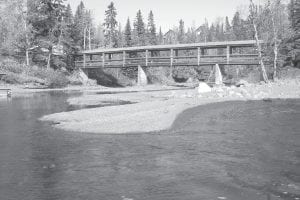l Current sources of sediment in the Poplar River are known, and certain things can be done to reduce that sediment, a but forever unknown might be the amount of sediment that would be in the friver anyway if people had never altered rthe land around it. At the June 6, 2011 meeting of the Poplar River Management Board (PRMB), University of Minnesota scientist John Niebur went over the results of a study — the third by several different hentities in recent years – he has finished on rsediment in the Poplar River.
Erosion continues along some portions of the lower couple of miles of the river as it tumbles down toward Lake Superior. It’s hard to know when and how some of these spots started, Niebur said. Roads, buildings, ski hills, and obsolete logging practices of over a hundred years ago have all lplayed a part. a From the study, Niebur concluded that significant sources of sediment in the lower
Poplar River are the Lutsen Mountains ski rslopes (because of the amount running off dper acre and because of the total amount of acreage), the forested areas (because of the total amount of acreage), and the yslumps — sediment on the edges of the river that ends up falling into the river and being carried downstream – because of the amount carried into the river per acre.
Capturing sediment and returning it to the land is one of the interventions Niebur recommended to keep sediment out of the Poplar River, and it is not a new practice.
He said farmers routinely capture eroded soil that washes off their fields and return it where it came from.
Niebur suggested three ways to capture sediment: 1) erecting structures that filter sediment while allowing water to pass through; 2) increasing vegetation in erosion-prone areas; and 3) increasing the land’s ability to absorb water to keep it from carrying sediment downhill with rainfalls and snow melts. Ski slopes that are not graded, for example, absorb water better than those that are.
Niebur admitted that this is not an exact science. Two researchers in the field could take readings 30 meters apart and get different results because of variations in the land. With more funding, more detailed research could be done, however.
Niebur was confident that his study produced enough reliable data to be useful in setting project priorities. PRMB engineer Curt Sparks said they will use the information from Niebur’s study to set priorities for projects they will pursue as they work on reducing sediment from the river.
Lutsen Mountains co-owner Tom Rider said all projects planned and funded or already completed up to this point are expected to reduce the amount of sediment by 48%.
Bids on one project funded by the Great Lakes Commission (GLC) on Ullr Mountain (a ski hill) came in significantly higher than engineers had estimated. The Cook County Soil & Water Conservation District will be working with the GLC on altering project plans as needed to fit within the grant amount.
Niebur made two recommendations: 1) Disperse the runoff that is concentrated where people have altered the land, such as near buildings and roads; and 2) intercept the sediment coming off the ski slopes.
Meanwhile, the Minnesota Pollution Control Agency (MPCA) is working on coming up with a new standard that measures sediment—and not biological organisms along with sediment—in the water. Karen Evens of the MPCA’s Duluth office said Niebur’s study would give them additional data they needed as they work on setting the standard.
“There’s always been sediment going down that river, even before man was there,” Sparks said. The PRMB has mitigated sources that were not caused by human activity along with those that were. He believes the natural state of the river might not meet the standards the MPCA might set, however.
New river trails
Sparks told the group he has been working with the Minnesota Department of Natural Resources (DNR) about developing a trail system along the lower Poplar River. This is a project that would be done independent of the PRMB.
The Poplar River and Lutsen Mountains has been under scrutiny recently after legislation was passed to increase the amount of water the ski hill can draw from the Poplar River for snowmaking. As the legislation was being drafted, it was learned that the ski hill had been taking more water from the river than allowed in its 1964 Minnesota Department of Natural Resources permit. Read more about this in next week’s Cook County News-Herald.



Loading Comments